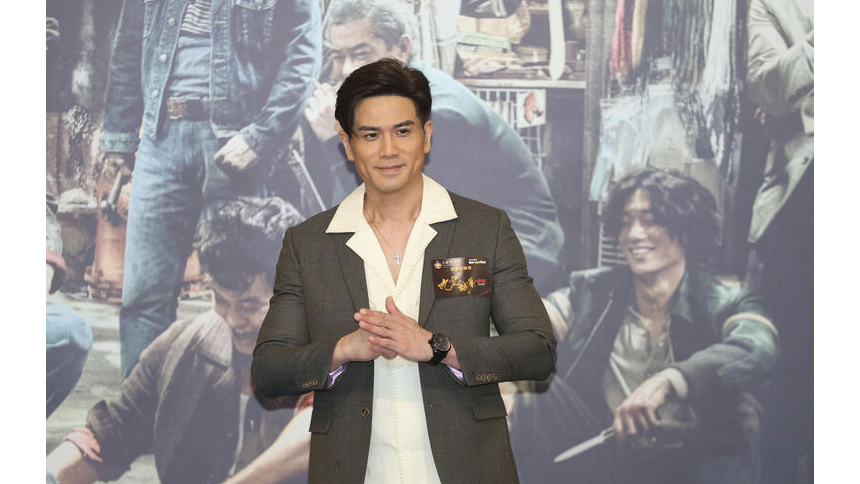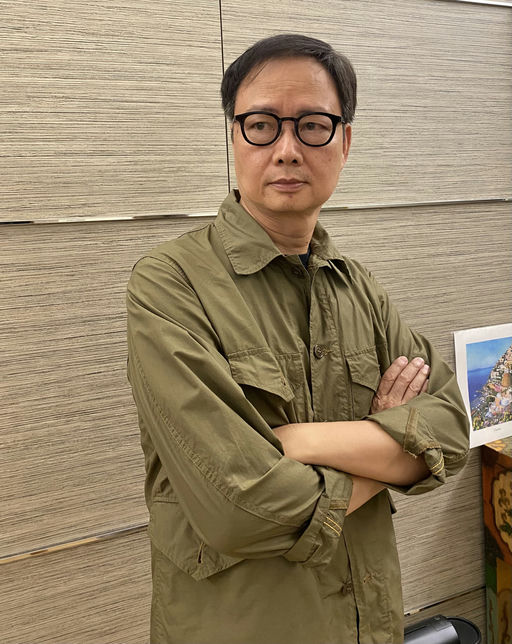New York Asian 2024 Interview: Philip Ng Talks TWILIGHT OF THE WARRIORS: WALLED IN

Hong Kong's top-grossing movie of the year is director Soi Cheang's Twilight of the Warriors: Walled In. Set largely in Kowloon Walled City (long since demolished), the martial arts blockbuster pits warring triads in a battle to the death over control of the tenement slum. Caught in the middle: hapless Mainlander Chan (Raymond Lam), whose search for an identity card has made him the target of expert assassins from both sides.
Led by heavyweights like Louis Koo, Richie Jen, Aaron Kwok, and the legendary Sammo Hung, Twilight is also a showcase for a younger generation of performers, like Philip Ng, who plays Sammo Hung's top killer King.
Philip Ng has starred in action films for almost 20 years, working with the some of the best in the industry, like Hung and Donnie Yen. He was a very credible Bruce Lee in 2016's Birth of the Dragon, with action choreography by the late Corey Yuen. Here Ng worked with stunt coordinator Kenji Tanigaki, a veteran of films like Donnie Yen's magnum opus Sakra (2023) and Blade II (2002).
We spoke with Ng and Twilight producer John Chong (Life Without Principle, A Beautiful Life, Infernal Affairs) before the US premiere of Twilight of the Warriors: Walled In.
Screen Anarchy: Did you have a special training regimen for TWILIGHT?
Philip Ng: I've been doing martial arts for quite a long time, since I was a child. My father owns a martial arts studio. When I'm filming, I work out about six days a week. Otherwise, to maintain, about four days a week. Mainly flexibility, cardio, weight training.
The training depends on the role. If I have to portray a martial arts method I'm not familiar with, then I would train more in that method. If I know there's a scene where I'm topless, I have to watch my diet and work on weight training. The fighting in Twilight of the Warriors is not too far off from what I normally do, so I didn't have to focus on specific training.
King, your character in TWILIGHT OF THE WARRIORS, is an out-and-out villain. Do you like playing that kind of role?
I played a lot of villains at the start of my career. I enjoy playing them, sure. You have more freedom. You don't have to protect the character as much as when you're playing the protagonist. You can go outside the boundaries of how you would normally create a character. It helps that I was working with a very good director who was able to let me know when I could go out of bounds or when he wanted me to reel it in a little.
Did you ever go too far?
I was afraid to in the beginning, because I didn't really feel like I found the character. On the first day I was still holding back a bit. On the second day, we shot an introduction scene with me and Sammo Hung. The scene didn't make it to the final cut, but there was a moment where my character gets to pick a weapon to kill someone. I did it like a child picking up toys, exaggerating it a bit. The more I did it, the more it felt like everyone on the set was enjoying the character.
It's always good to have someone like Soi there, someone you can trust. Sometimes I'm not exactly sure what he has in mind, how a scene correlates to what comes before or after. So you really have to trust the director.
Your outrageous outfits and Elvis Presley sunglasses must have helped with your character.
That was Soi's direction. There's a lot of fighting is this film. I asked him if I had to keep the glasses on the whole time, and he said, "Yeah." I think he was trying to create an image, kind of like Batman with his mask. Without that mask, he's just Bruce Wayne.
Soi wanted each character to have a very specific image, so the audience could see someone and know what was coming.
Soi Cheung has an incredible vision which he manages to bring to the screen intact, like his last film MAD FATE.
I've always loved his movies, so when he called me in, I didn't even care what role he was offering. After our third meeting, he said, "Phil, you've been making films for 20 years. People know who you are. But once you get into costume here, they aren't going to recognize you."
What's it like working with someone like Sammo Hung?
This is I think the fifth movie I've worked on with him, but every time I see him, I'm still a fanboy, right? I still get nervous. You want to be on the ball, you don't want to hurt your opponent, especially someone like Sammo. He was very game with our scenes, giving suggestions on how to do this, do that. He was so involved, so enthusiastic, that it made it a lot easier.
It's always great working with Mr. Hung because he makes you feel comfortable. The first time I fought him in a movie was around 15 or 20 years ago. I was kind of green. But when you fight him, he'll help you. Like if you're supposed to duck and you forget, he'll push your head down, punch over your head, and then bring you back up so the camera can see you. When you look at the playback, and you think you've messed up, it looks great because he's such a pro. Working with him makes your performance better.
Do you get to contribute to the action choreography?
I like to maintain boundaries, make sure that the person in charge has authority. It was Kenji this time. We're great friends. What's amazing about Kenji is that he trained in the Hong Kong action movie method. He came to Hong Kong three decades ago, and really learned the craft. But at the same time, he injected his own cultural preferences into his choreography, like his love of Manga anime.
In Twilight of the Warriors, you see the Hong Kong base, with a kind of cultural uniqueness. It's in the way he shoots, the action, the speed, people running. It's very distinctly his style. But he still discusses everything with the director.
Like the scene where Louis Koo first meets Raymond Lam. Louis punches Raymond so hard he spins into the wall. So Soi and Kenji discussed how much he should spin. "Let's try two spins." That's too much. "How about one spin?" It's still too much. "Half a spin?" Okay, that's perfect. No spin at all would be too boring. They had to find a tone. Once they established that, then they let Kenji just kind of create.
Kenji and I had a lot of discussions at first. I was a little bit concerned when I saw the way that he choreographed Sammo and the elders. Sammo and Louis Koo, they were really hardcore, old school, like fighting in the eighties and nineties. When Kenji choreographed our stuff, the four younger guys and my character, it was more modern, non-traditional. I wondered if the non-traditional fighting would show off the character's power. We had a good discussion and then we kind of came up with a middle ground where the movements are unique, it still seems powerful.
Can you talk about rehearsing your very complicated fight scenes?
There's a lot of prep work involved. Kenji used pre-vis, so everyone was ready when we got on set.
The sets are so spectacular, with ladders, cables, corrugated roofing. Did that make the fighting more difficult?
We used three main sets: the street; the hallways, where I chase the four guys in the middle of the movie; and the rooftop, where they are pieces of movable buildings. We had another set in an abandoned school where King does his ceremony in the courtyard.
The production design crew [led by Kwok-Keung Mak] made the sets so they were like Lego pieces. We could move them to put the camera in safe positions. Where the locations look very narrow, we can actually open the set up and move around.
You're being too modest about this, because the fights look incredibly difficult to stage. They stretch out through several areas. How long would it take to put one of the fights together?
The ending took a long time, I think 20 days. That's because we filmed very detailed action, a lot more than what made it into the film.
How do you maintain momentum and pacing over 20 days?
That's just Hong Kong filming ingenuity. We're just used to working that way. Everyone's very organized, very professional. As an actor, I'm not going to lie. It was physically demanding. But we didn't have to worry about getting it done because the crew was so strong.
Mr. Chong, was this a difficult film to finance?
John Chong: We started working on this eight years ago. The script was hard. The story's based on City of Darkness by Yuyi, and it was hard to adapt it to the screenplay format. That took about three years.
It was a challenge to land Soi Cheang, but we worked together on a film called Accident in 2009. That starred Louis Koo, and once he joined the team it became easier to attract funding.
Our real challenge was how to make Twilight of the Warriors good. We had some very good veteran actors, but we also needed to cast a new generation. When Soi told me he was casting Philip as a villain, I said, "That's impossible. He's such a decent guy, really good and humble. How can he be a villain? He's so handsome."
Soi said leave it to me. The same thing happened with Raymond Lam, someone I've known for a long time. He's a real gentleman. Then one day I'm on the set and I asked, "Where's Raymond?" And they point to the guy fighting. He was a totally different person, really fantastic.
Having such a big hit must be a good feeling.
I've produced quite a few films, but this one is really special. The whole thing is like a dream.
There's a real appetite for films like this. Philip, can you say anything about your next film?
We're in post right now for Without Remorse. We're pretty satisfied with the fight scenes. Obviously, the budget wasn't as big as Twilight of the Warriors, but we got a lot of my buddies on the project: Andy On, Sammy Hong, Sammo's son, and Tiger Chen. Hopefully we can share it with the world this November.









